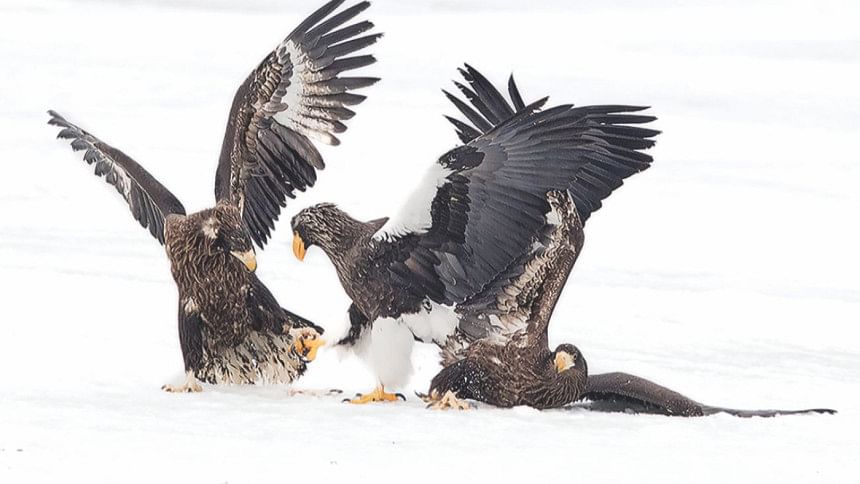The Eagles of Hokkaido

For birders, a trip to Hokkaido during winter revolves around the Red-crowned Crane. However, there are several other spectacular birds that one can see in Hokkaido in winter.
Among them are two eagles, Steller's Sea Eagle and the White-tailed Eagle. During a recent trip to this northernmost island of Japan, I had the opportunity to observe both.
Steller's Sea Eagle is one of the world's largest birds of prey. It can weigh up to ten kilograms which is half a kilogram heavier than the famed Harpy Eagle of South America. Growing to a meter in length, its wingspan can reach over two meters. Compared to its length, it has a relatively short, diamond-shaped white tail. Mostly dark brown, this eagle has splashes of white on its body, notably a long patch on each shoulder.
Its most remarkable feature is its large and bulb-shaped orange beak. One would not want to be on its receiving end. The bird catches fish from the sea and hunts smaller birds including all manners of water fowl and gulls.
Steller's Sea Eagles live most of the year in northeastern Asia, particularly Kamchatka Peninsula, where they breed. They migrate to northern Japan during the winter and feed off the fish of surrounding waters.
The White-tailed Eagle, on the other hand, makes Hokkaido its year-round home. It, too, is a large eagle with a weight of up to seven kilograms, length of slightly less than a meter, and wingspan similar to that of the Steller's Sea Eagle. The adults are dirty grey in colour with a pronounced white band seen on its tail while in flight, much like our Pallas's Fish Eagles. The younger eagles are coloured more rust and brown.
For both these eagles, females are larger and heavier than males. This difference allows males and females to target different sets of prey, thus reducing the area they must cover to feed themselves.
My first sighting of these eagles was at the fishermen's town Furen near the frozen Lake Furen on the northeastern corner of Hokkaido. The town borders the Pacific Ocean where the fishermen catch fish. White-tailed Eagles were perched on top of large, leafless trees, with an occasional Steller's Sea Eagle in the mix.
Later, near the town of Nemuro, I saw both types of eagles on a snow field where they dived for fish put out for them. About two dozen eagles were already on the snow. Some had claimed their piece of fish and spread their wings like an umbrella around it to ward off other birds – a behaviour known as mantling. More eagles flew in and landed among them. A band of crows surrounded them looking for a morsel or two and when one got too close it was chased away. When a fight broke out, it was usually between eagles of the same species. The fish was soon gone and so were the eagles, except for a couple of lonely looking sea eagles which sat despondent in the snow.
That same afternoon, we saw the nest of a White-tailed Eagle on a tall tree on the mountainside. Like other eagle nests I have seen, it was a jumble of branches and twigs. The female White-tailed Eagle lays between one and three eggs per year and parents take turn incubating them for forty days before they hatch.
facebook.com/ikabirphotographs or follow “ihtishamkabir” on Instagram

 For all latest news, follow The Daily Star's Google News channel.
For all latest news, follow The Daily Star's Google News channel. 



Comments